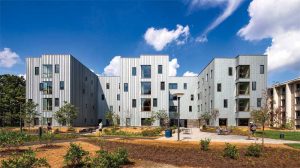| ZINC FAÇADE AT DICKINSON COLLEGE |
 Photos © Chris Cooper. Photo courtesy RHEINZINK The High Street Residence Hall at Dickinson College in Carlisle, Pennsylvania, showcases modern student living inside, and a zinc façade in durable, distinctive, and sustainable cladding on the outside. As the first residence constructed since 1978 on the historic campus, High Street opened in August 2018, and in January 2019, earned the Leadership in Energy and Environmental Design (LEED) Platinum certification from the The new building takes a prominent place on the main thoroughfare of the city where this private, liberal arts college has welcomed students since 1783. The campus hosts numerous architectural styles, unified by their stone exteriors. Designed by Deborah Berke Partners and built by Benchmark Construction, the residence also incorporates limestone, as well as other natural materials like mahogany accents and zinc. The combination of materials bridges historic formality and a modern, friendly appearance. The stone-faced front of the building suits Dickinson’s legacy, while the back provides a more contemporary, casual connection to the campus lawn and a nod to the local agricultural vernacular. Here, the zinc material manufacturer provided pre-weathered blue-gray panels to wrap High Street’s southern elevation and frame variable-sized window openings. The e-shaped, 3763-m2 (40,500-sf), four-story building offers 85 private and double room configurations along with study areas, community kitchen, indoor bike storage, and other communal spaces. The three dominant façade materials provide a changing canvas that evolves in coloration as they age and weather. The sun will bleach the dark-gray limestone ashlar. The mahogany strips will darken to a leaden tone. The zinc blue-gray material will continue to develop its soft gray, natural patina. “The dynamic aesthetic of [the zinc] façade cladding makes it a perfect choice for a student residence hall on an active campus, and the natural advantages of zinc support the college’s exceptional commitment to sustainability,” said Chuck Bell, regional sales manager with a manufacturer of architectural zinc products. Enhancing the building’s visual interest, the zinc panels were installed by Novinger’s in a randomized pattern. “The architect determined the pattern and we put it in place,” noted Rick Becker, project superintendent with Novinger’s. “The windows served as our guide, as everything had to line up to them.” Since zinc was a new material for Novinger’s, Becker said they brought in Craig Hardin as a training consultant with experience installing the zinc manufacturer’s material and wall cladding. “He shared his tool list, and worked with us on the right techniques including some scallop details that we wanted to perfect.” To further ensure the correct appearance and proper installation, Novinger’s installed a mockup onsite for the project team’s review prior to beginning the full project. Once approved, Novinger’s went to work with a field team of six to eight people who worked through the changing seasons. Pre-weathered zinc material was used to fabricate vertically oriented, standing-seam panels. “All of the panels—1719 m2 (18,500 sf) of them—are hand-formed, hand-seamed, and precision-made with a computerized brake and shear,” explained Jim Cashman from Pennsylvania-based building materials supplier. “They are sized in 152, 229, and 295-mm (6, 9, and 12-in.) widths, with a 38-mm (1.5-in) raised seam. We also made lots of custom panels and the coping caps.” Cashman elaborated, “The standing-seam panel sides have a single-lock connection and are connected horizontally with a hook lock, while stainless steel clips hold the panels in place. Behind the panels is…framing system with a mineral wool insulation, which provides the thermal break.” “Zinc is a fairly soft metal that requires careful attention when working with it in cold climates, as with this project,” Cashman said. “Fieldwork during the winter requires the zinc to be warmed, so it bends, rather than cracks.” Aside from these cautionary notes, Cashman is quick to praise the zinc material. “It is a nice material. It is an Old World, European material that has been around hundreds of years. I am glad to see it become popular here.” Appealing to campus facility managers, the zinc material maintains its self-healing, low-maintenance, corrosion-resistant performance with a long lifespan. “LEED Platinum status is a true accomplishment and a unique distinction for the college,” said Ken Shultes, associate vice-president for sustainability and facilities planning at Dickinson College. “It is safe to say we have raised the sustainability bar with this new building.” Other attributes contributing to the building’s LEED Platinum status include:
According to the college, High Street Residence Hall is only one of approximately 50 LEED Platinum-certified projects in Pennsylvania, and the only one directly associated with an institution of higher education. Dickinson also has stated its commitment to carbon-free operations by 2020. |
Specifying zinc façades
Got News? Click here to share your story!




